JSTL和EL表达式:

EL表达式:为了替换out.println(),用于简化jsp的输出

测试案例:
Student.java类:
package com.imooc.el;
public class Student {
//属性
private String name;//姓名
private String mobile;//手机号
//setter getter
public String getName() {
return name;
}
public void setName(String name) {
this.name = name;
}
public String getMobile() {
return mobile;
}
public void setMobile(String mobile) {
this.mobile = mobile;
}
}
StudentServlet:
package com.imooc.el;
import java.io.IOException;
import javax.servlet.ServletException;
import javax.servlet.annotation.WebServlet;
import javax.servlet.http.HttpServlet;
import javax.servlet.http.HttpServletRequest;
import javax.servlet.http.HttpServletResponse;
/**
* Servlet implementation class StudentServlet
*/
@WebServlet("/info")
public class StudentServlet extends HttpServlet {
private static final long serialVersionUID = 1L;
/**
* @see HttpServlet#HttpServlet()
*/
public StudentServlet() {
super();
// TODO Auto-generated constructor stub
}
/**
* @see HttpServlet#doGet(HttpServletRequest request, HttpServletResponse response)
*/
protected void doGet(HttpServletRequest request, HttpServletResponse response) throws ServletException, IOException {
Student stu = new Student();
stu.setName("子墨");
stu.setMobile(null);
String grade = "A";
request.setAttribute("student", stu);
request.setAttribute("grade", grade);
//将请求转发到el_info.jsp页面
request.getRequestDispatcher("/el_info.jsp").forward(request, response);
}
}
el_info.jsp:EL表达式只能在jsp页面使用,不可以用在HTML页面中
<%@ page language="java" contentType="text/html; charset=UTF-8"
pageEncoding="UTF-8"%>
<!DOCTYPE html>
<html>
<head>
<meta charset="UTF-8">
<title>Insert title here</title>
</head>
<body>
<!-- 不需要考虑导入问题,而且格式也相当于HTML格式 -->
<h1>姓名: ${requestScope.student.name}</h1>
<h2>手机: ${requestScope.student.mobile}</h2>
<h2>评级: ${requestScope.grade}</h2>
</body>
</html>
输出结果:值为null的会输出空白

EL的作用域对象:

测试案例:
StudentServlet:
package com.imooc.el;
import java.io.IOException;
import javax.servlet.ServletException;
import javax.servlet.annotation.WebServlet;
import javax.servlet.http.HttpServlet;
import javax.servlet.http.HttpServletRequest;
import javax.servlet.http.HttpServletResponse;
import javax.servlet.http.HttpSession;
/**
* Servlet implementation class StudentServlet
*/
@WebServlet("/info")
public class StudentServlet extends HttpServlet {
private static final long serialVersionUID = 1L;
/**
* @see HttpServlet#HttpServlet()
*/
public StudentServlet() {
super();
// TODO Auto-generated constructor stub
}
/**
* @see HttpServlet#doGet(HttpServletRequest request, HttpServletResponse response)
*/
protected void doGet(HttpServletRequest request, HttpServletResponse response) throws ServletException, IOException {
Student stu = new Student();
stu.setName("子墨");
stu.setMobile(null);
String grade = "A";
//请求作用域
request.setAttribute("grade", "B");
//全局作用域
request.getServletContext().setAttribute("grade", "C");
HttpSession session = request.getSession();
//session作用域
session.setAttribute("student", stu);
session.setAttribute("grade", grade);
//将请求转发到el_info.jsp页面
request.getRequestDispatcher("/el_info.jsp").forward(request, response);
}
}
el_info.jsp:不写作用域,或从范围从小到大依次匹配
<%@ page language="java" contentType="text/html; charset=UTF-8"
pageEncoding="UTF-8"%>
<!DOCTYPE html>
<html>
<head>
<meta charset="UTF-8">
<title>Insert title here</title>
</head>
<body>
<!-- 不需要考虑导入问题,而且格式也相当于HTML格式 -->
<h1>姓名: ${student.name}</h1>
<h2>手机: ${student.mobile}</h2>
<h2>评级: ${grade}</h2>
</body>
</html>
输出结果:输出作用域范围最小的request的值
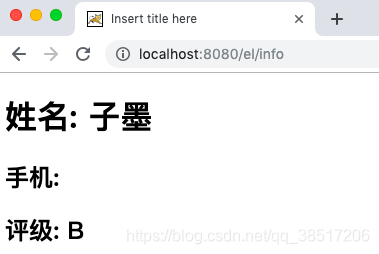
EL表达式输出:
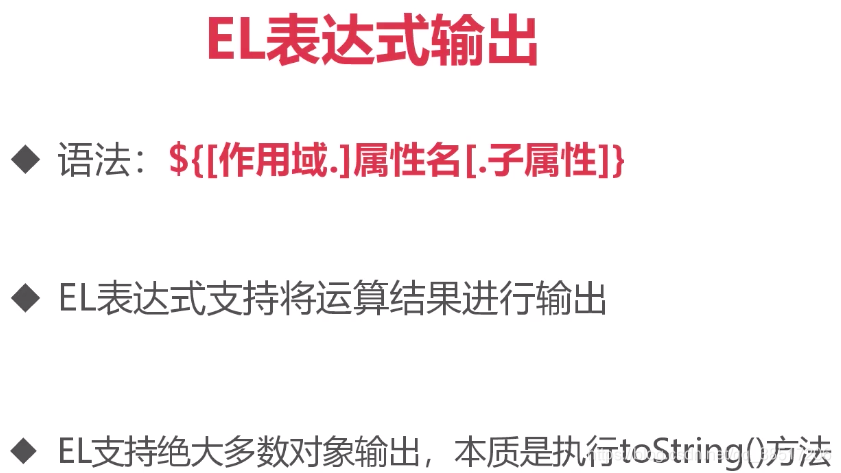

EL输出参数值:
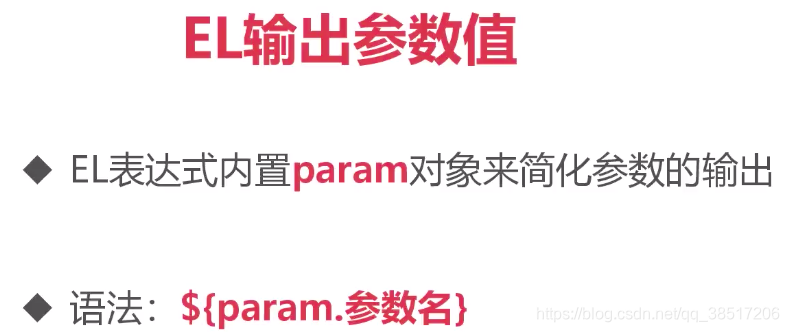
测试案例:
StudentServlet:
package com.imooc.el;
import java.io.IOException;
import javax.servlet.ServletException;
import javax.servlet.annotation.WebServlet;
import javax.servlet.http.HttpServlet;
import javax.servlet.http.HttpServletRequest;
import javax.servlet.http.HttpServletResponse;
import javax.servlet.http.HttpSession;
/**
* Servlet implementation class StudentServlet
*/
@WebServlet("/info")
public class StudentServlet extends HttpServlet {
private static final long serialVersionUID = 1L;
/**
* @see HttpServlet#HttpServlet()
*/
public StudentServlet() {
super();
// TODO Auto-generated constructor stub
}
/**
* @see HttpServlet#doGet(HttpServletRequest request, HttpServletResponse response)
*/
protected void doGet(HttpServletRequest request, HttpServletResponse response) throws ServletException, IOException {
//获取传来的参数
String teacher = request.getParameter("teacher");
Student stu = new Student();
stu.setName("子墨");
stu.setMobile(null);
String grade = "A";
HttpSession session = request.getSession();
//session作用域
session.setAttribute("student", stu);
session.setAttribute("grade", grade);
//将请求转发到el_info.jsp页面
request.getRequestDispatcher("/el_info.jsp").forward(request, response);
}
}
el_info.jsp:
<%@ page language="java" contentType="text/html; charset=UTF-8"
pageEncoding="UTF-8"%>
<!DOCTYPE html>
<html>
<head>
<meta charset="UTF-8">
<title>Insert title here</title>
</head>
<body>
<!-- 不需要考虑导入问题,而且格式也相当于HTML格式 -->
<h1>姓名: ${student.name}</h1>
<!-- EL表达式不输出null,会使用空字符串替代 -->
<h2>手机: ${student.mobile}</h2>
<!-- 获取传来的参数 -->
<h2>讲师: ${param.teacher}</h2>
<h2>评级: ${grade}</h2>
<h2>概要: ${student}</h2>
</body>
</html>
在浏览器输入:
http://localhost:8080/el/info?teacher=sammy
输出结果:
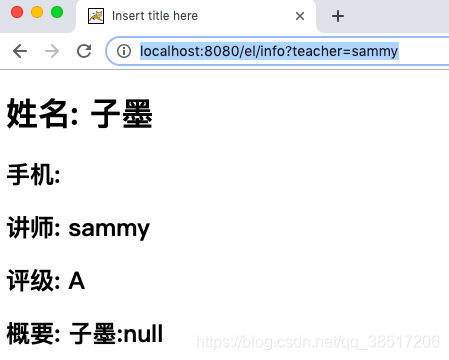
JSTL标签库:
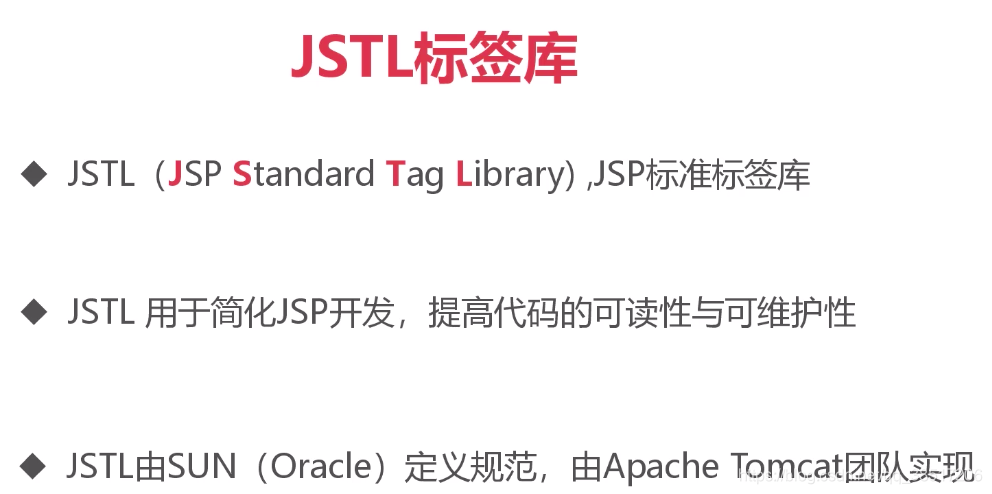
下载JSTL标签库: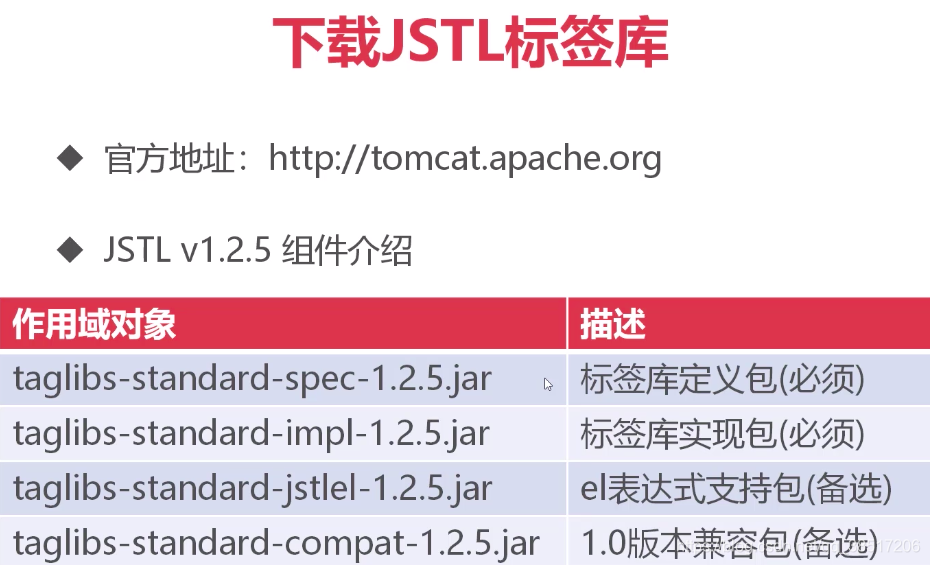
已经下载成功:
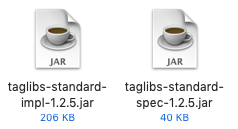
安装JSTL标签库:
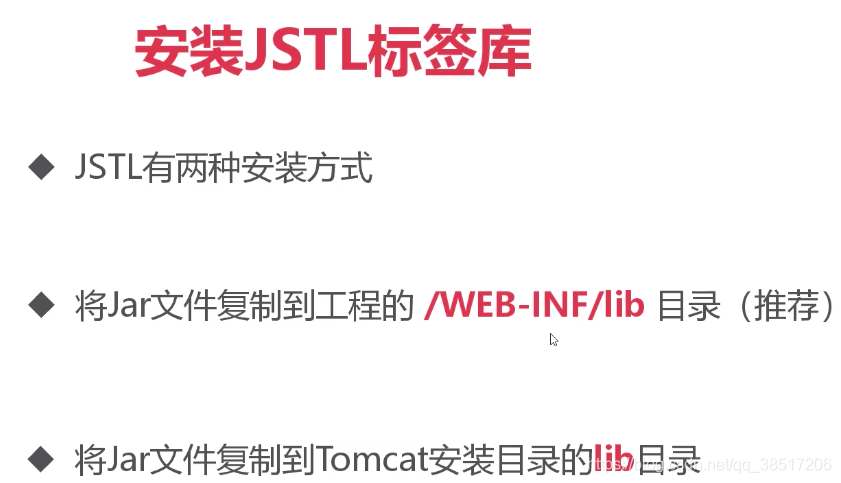
1、只需要将两个jar包复制到lib目录下,就会自动出现在Web App Libraries里,只在本工程有效
2、或者直接将两个jar包复制到tomcat的lib目录
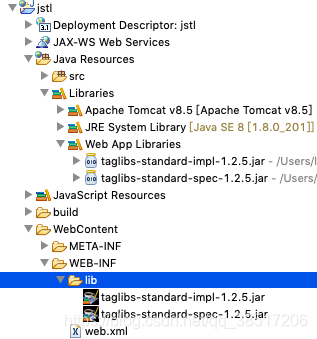
JSTL的标签库:
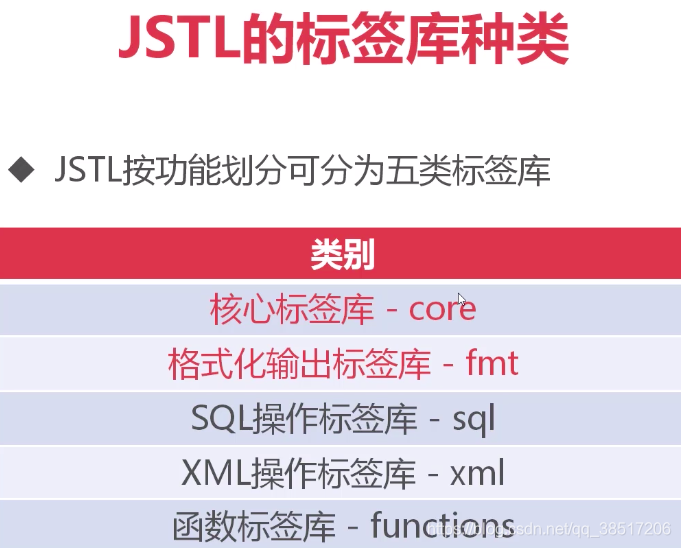
核心标签库:
引用JSTL核心库:
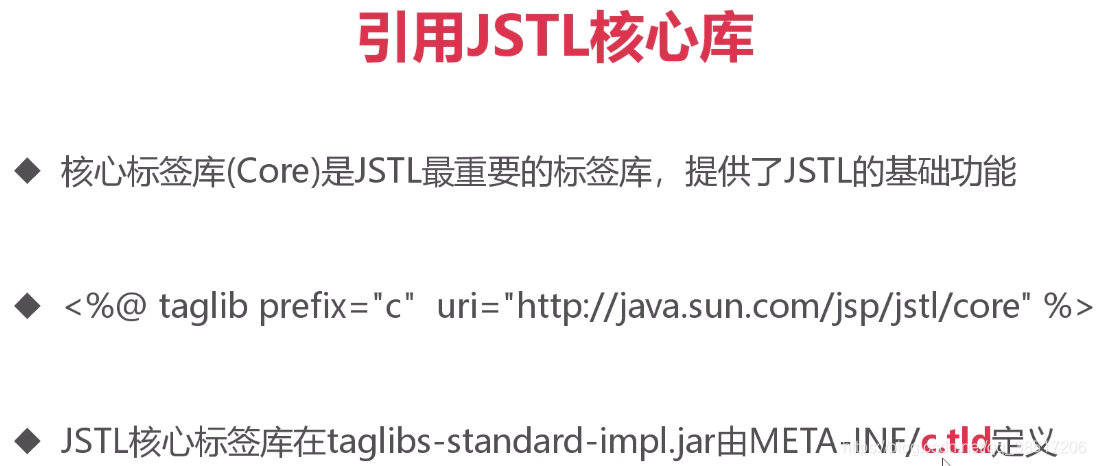
core.jsp:
<%@ page language="java" contentType="text/html; charset=UTF-8"
pageEncoding="UTF-8"%>
<!-- 在java或者jsp文件输入 Alt+/ 可出现智能提示 -->
<%@ taglib uri="http://java.sun.com/jsp/jstl/core" prefix="c"%>
<!DOCTYPE html>
<html>
<head>
<meta charset="UTF-8">
<title>Insert title here</title>
</head>
<body>
<c:if test=""></c:if>
</body>
</html>
JSTL判断标签:
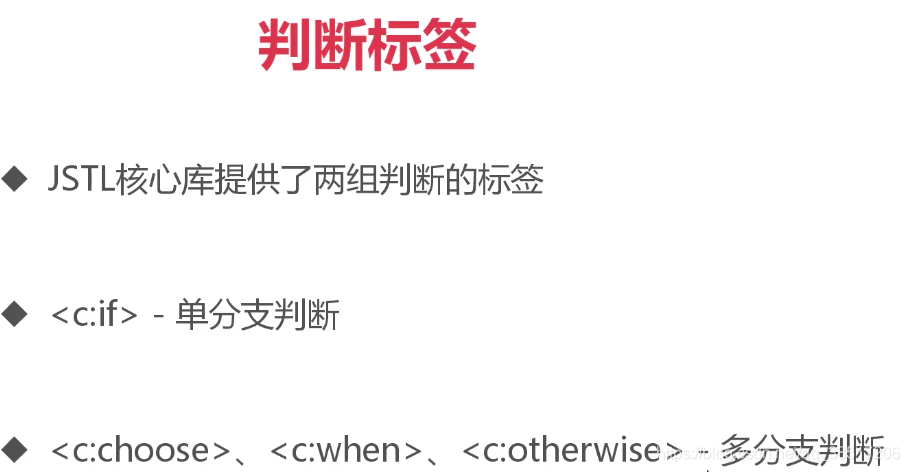
单分支判断的使用:
JstlServlet:
package com.imooc.jstl;
import java.io.IOException;
import javax.servlet.ServletException;
import javax.servlet.annotation.WebServlet;
import javax.servlet.http.HttpServlet;
import javax.servlet.http.HttpServletRequest;
import javax.servlet.http.HttpServletResponse;
/**
* Servlet implementation class JstlServlet
*/
@WebServlet("/jstl")
public class JstlServlet extends HttpServlet {
private static final long serialVersionUID = 1L;
/**
* @see HttpServlet#HttpServlet()
*/
public JstlServlet() {
super();
// TODO Auto-generated constructor stub
}
/**
* @see HttpServlet#doGet(HttpServletRequest request, HttpServletResponse response)
*/
protected void doGet(HttpServletRequest request, HttpServletResponse response) throws ServletException, IOException {
request.setAttribute("score",58);
request.setAttribute("grade","B");
request.getRequestDispatcher("/core.jsp").forward(request, response);
}
}
core.jsp:
<%@ page language="java" contentType="text/html; charset=UTF-8"
pageEncoding="UTF-8"%>
<!-- 在java或者jsp文件输入 Alt+/ 可出现智能提示 -->
<%@ taglib uri="http://java.sun.com/jsp/jstl/core" prefix="c"%>
<!DOCTYPE html>
<html>
<head>
<meta charset="UTF-8">
<title>Insert title here</title>
</head>
<body>
<h1>${requestScope.score}</h1>
<c:if test="${score>=60 }">
<h1 style="color:green">恭喜,你已通过测试</h1>
</c:if>
<c:if test="${score<60 }">
<h1 style="color:red">sorry,你未通过测试</h1>
</c:if>
</body>
</html>
成绩为58时,输出结果:
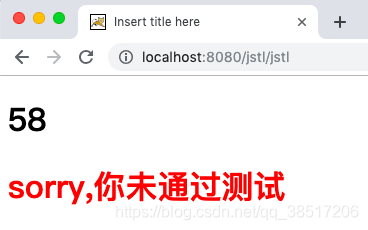
成绩为90时,输出结果:
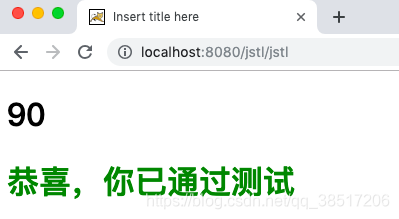
多分支判断的使用:
core.jsp:
<%@ page language="java" contentType="text/html; charset=UTF-8"
pageEncoding="UTF-8"%>
<!-- 在java或者jsp文件输入 Alt+/ 可出现智能提示 -->
<%@ taglib uri="http://java.sun.com/jsp/jstl/core" prefix="c"%>
<!DOCTYPE html>
<html>
<head>
<meta charset="UTF-8">
<title>Insert title here</title>
</head>
<body>
<h1>${requestScope.score}</h1>
<!-- if -->
<!-- 进行单分支判断 -->
<c:if test="${score>=60 }">
<h1 style="color:green">恭喜,你已通过测试</h1>
</c:if>
<c:if test="${score<60 }">
<h1 style="color:red">sorry,你未通过测试</h1>
</c:if>
<!-- choose when otherwise -->
<!-- 进行多分支判断 -->
<h1>${grade}</h1>
<c:choose>
<c:when test="${grade =='A' }">
<h2 style="color:pink">你很优秀</h2>
</c:when>
<c:when test="${grade =='B' }">
<h2 style="color:red">不错哦</h2>
</c:when>
<c:when test="${grade =='C' }">
<h2 style="color:orange">继续加油</h2>
</c:when>
<c:when test="${grade =='D' }">
<h2 style="color:green">辣鸡</h2>
</c:when>
<c:otherwise>
<h2 style="color:green">一切随缘吧</h2>
</c:otherwise>
</c:choose>
</body>
</html>
输出结果:
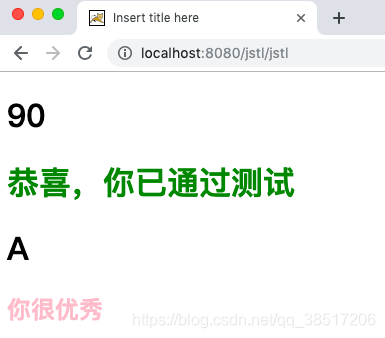
JSTL遍历集合:
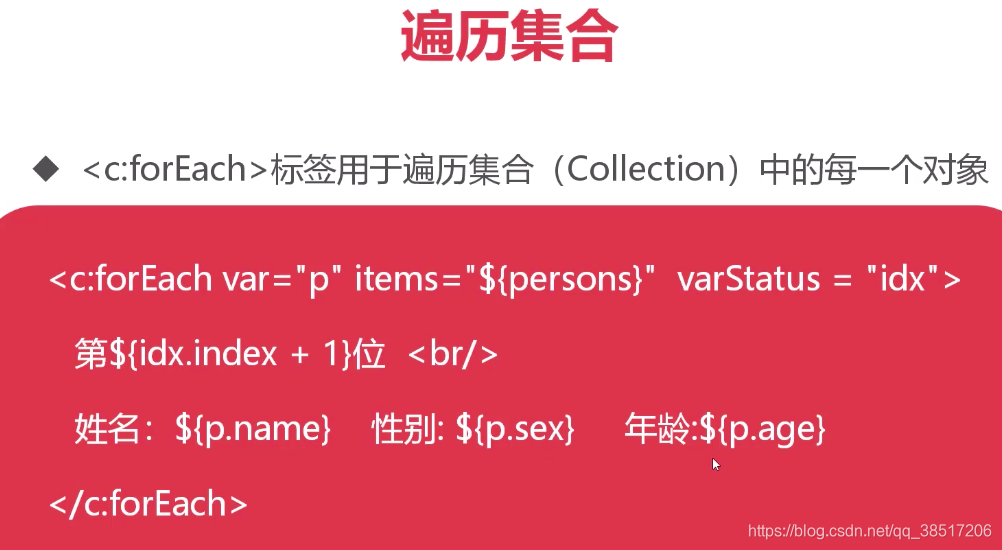
案例测试:
Company.java:
package com.imooc.jstl;
public class Company {
//属性
private String cname;//mingzi
private String url;
//带参构造
public Company(String cname, String url) {
super();
this.cname = cname;
this.url = url;
}
//setter getter
public String getCname() {
return cname;
}
public void setCname(String cname) {
this.cname = cname;
}
public String getUrl() {
return url;
}
public void setUrl(String url) {
this.url = url;
}
}
JstlServlet:
package com.imooc.jstl;
import java.io.IOException;
import java.util.ArrayList;
import java.util.List;
import javax.servlet.ServletException;
import javax.servlet.annotation.WebServlet;
import javax.servlet.http.HttpServlet;
import javax.servlet.http.HttpServletRequest;
import javax.servlet.http.HttpServletResponse;
/**
* Servlet implementation class JstlServlet
*/
@WebServlet("/jstl")
public class JstlServlet extends HttpServlet {
private static final long serialVersionUID = 1L;
/**
* @see HttpServlet#HttpServlet()
*/
public JstlServlet() {
super();
// TODO Auto-generated constructor stub
}
/**
* @see HttpServlet#doGet(HttpServletRequest request, HttpServletResponse response)
*/
protected void doGet(HttpServletRequest request, HttpServletResponse response) throws ServletException, IOException {
List list = new ArrayList();
list.add(new Company("腾讯","www.baidu.com"));
list.add(new Company("阿里","www.ali.com"));
list.add(new Company("华为","www.huawei.com"));
//将集合存储在请求中
request.setAttribute("companies", list);
request.getRequestDispatcher("/core.jsp").forward(request, response);
}
}
core.jsp:
<%@ page language="java" contentType="text/html; charset=UTF-8"
pageEncoding="UTF-8"%>
<!-- 在java或者jsp文件输入 Alt+/ 可出现智能提示 -->
<%@ taglib uri="http://java.sun.com/jsp/jstl/core" prefix="c"%>
<!DOCTYPE html>
<html>
<head>
<meta charset="UTF-8">
<title>Insert title here</title>
</head>
<body>
<!-- forEach 标签用于遍历集合
List companies = (List)request.getAttribute("companies");
for(Company c:companies){
out.println(...);
}
-->
<c:forEach items="${requestScope.companies }" var="c" varStatus="idx">
<h2 style="color:pink">${idx.index+1}.${c.cname }-${c.url }</h2>
</c:forEach>
</body>
</html>
输出结果:
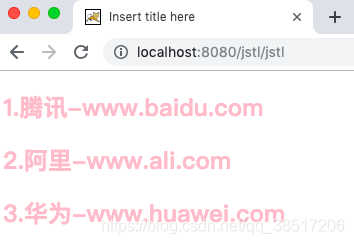
fmt格式化标签库:比较重要的就是日期标签库和数字标签库
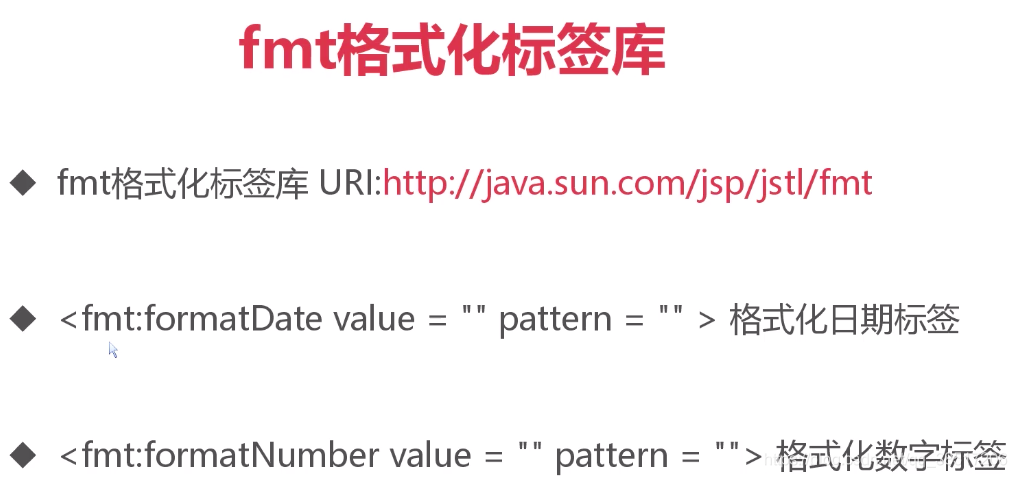
日期标签库的用处:
fmt.jsp:
<%@ page language="java" contentType="text/html; charset=UTF-8"
pageEncoding="UTF-8"%>
<%@ taglib uri="http://java.sun.com/jsp/jstl/fmt" prefix="fmt" %>
<!DOCTYPE html>
<html>
<head>
<meta charset="UTF-8">
<title>Insert title here</title>
</head>
<body>
<%
request.setAttribute("amt",1980983.894);
request.setAttribute("now",new java.util.Date());
request.setAttribute("html","<a href='index.html'>index</a>");
request.setAttribute("nothing",null);
%>
<!--
formData pattern
yyyy - 四位年
MM - 两位月
dd - 两位日
HH - 24小时制
hh - 12小时制
mm - 分钟
ss - 秒数
SSS - 毫秒
-->
<h2>原始数据:${now }</h2>
<h2>格式化后数据:<fmt:formatDate value="${requestScope.now }" pattern="yyyy年mm月dd日 HH时mm分ss秒SSS毫秒"/></h2>
</body>
</html>
输出结果:

综合测试:
fmt.jsp:
<%@ page language="java" contentType="text/html; charset=UTF-8"
pageEncoding="UTF-8"%>
<%@ taglib uri="http://java.sun.com/jsp/jstl/fmt" prefix="fmt" %>
<%@ taglib uri="http://java.sun.com/jsp/jstl/core" prefix="c" %>
<!DOCTYPE html>
<html>
<head>
<meta charset="UTF-8">
<title>Insert title here</title>
</head>
<body>
<%
request.setAttribute("now",new java.util.Date());
request.setAttribute("amt",1980983.897);
request.setAttribute("html","<a href='index.html'>index</a>");
request.setAttribute("nothing",null);
%>
<!--
formData pattern
yyyy - 四位年
MM - 两位月
dd - 两位日
HH - 24小时制
hh - 12小时制
mm - 分钟
ss - 秒数
SSS - 毫秒
-->
<h2>原始数据:${now }</h2>
<h2>格式化后数据:<fmt:formatDate value="${requestScope.now }" pattern="yyyy年mm月dd日 HH时mm分ss秒SSS毫秒"/></h2>
<h2>原始金额:${amt }元</h2>
<h2>格式化后金额:¥<fmt:formatNumber value="${requestScope.amt }" pattern="0,000.00"/>元</h2>
<h2>null默认值:<c:out value="${nothing }" default="无"></c:out></h2>
<!-- 使得显示HTML源代码 -->
<h2>${html }</h2>
<h2><c:out value="${html }" escapeXml="true"></c:out></h2>
</body>
</html>
输出结果:
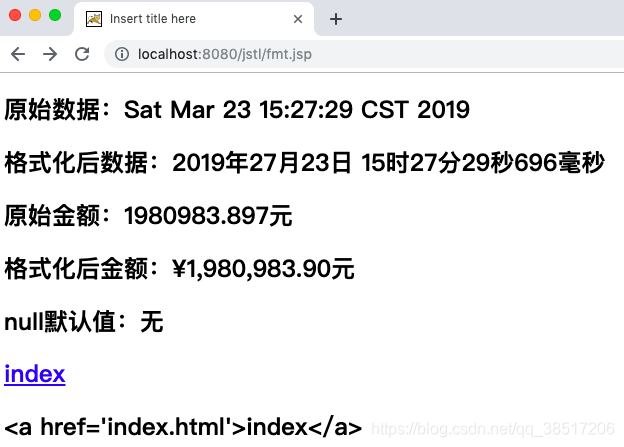
开发ali员工信息表:
暂时搁置





 本文介绍了JavaWeb中的JSTL和EL表达式,讲解了EL表达式的使用,包括其简化jsp输出的功能,以及EL的作用域对象。接着详细阐述了JSTL标签库的下载、安装和应用,如核心标签库中的判断标签和遍历集合,以及fmt格式化标签库在日期和数字格式化中的应用。通过实例展示了如何在实际开发中运用这些技术。
本文介绍了JavaWeb中的JSTL和EL表达式,讲解了EL表达式的使用,包括其简化jsp输出的功能,以及EL的作用域对象。接着详细阐述了JSTL标签库的下载、安装和应用,如核心标签库中的判断标签和遍历集合,以及fmt格式化标签库在日期和数字格式化中的应用。通过实例展示了如何在实际开发中运用这些技术。
















 1102
1102

 被折叠的 条评论
为什么被折叠?
被折叠的 条评论
为什么被折叠?








